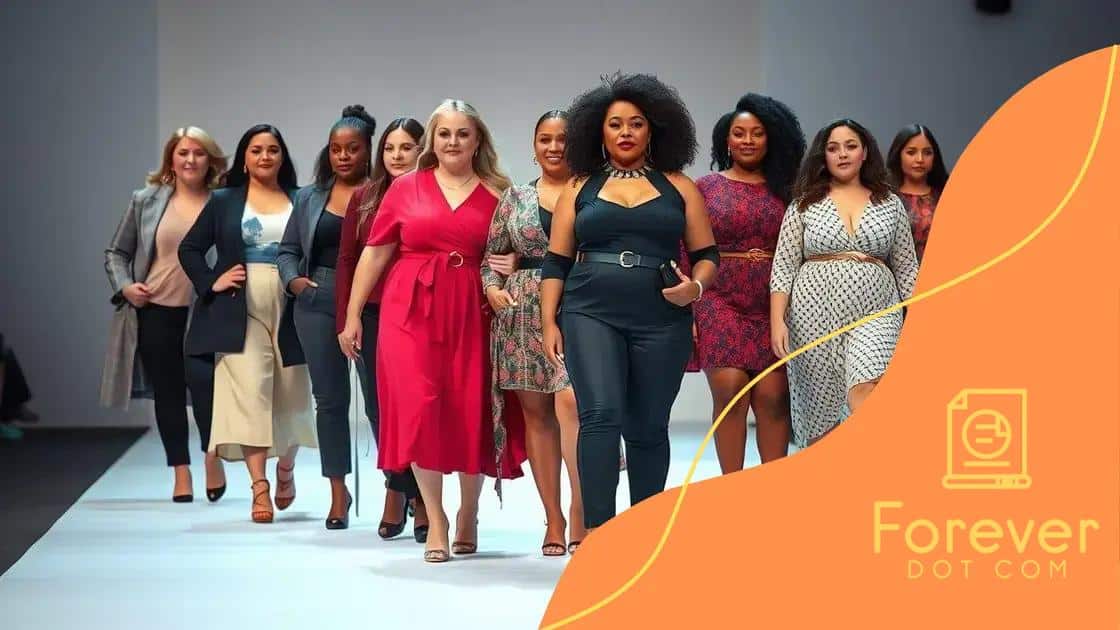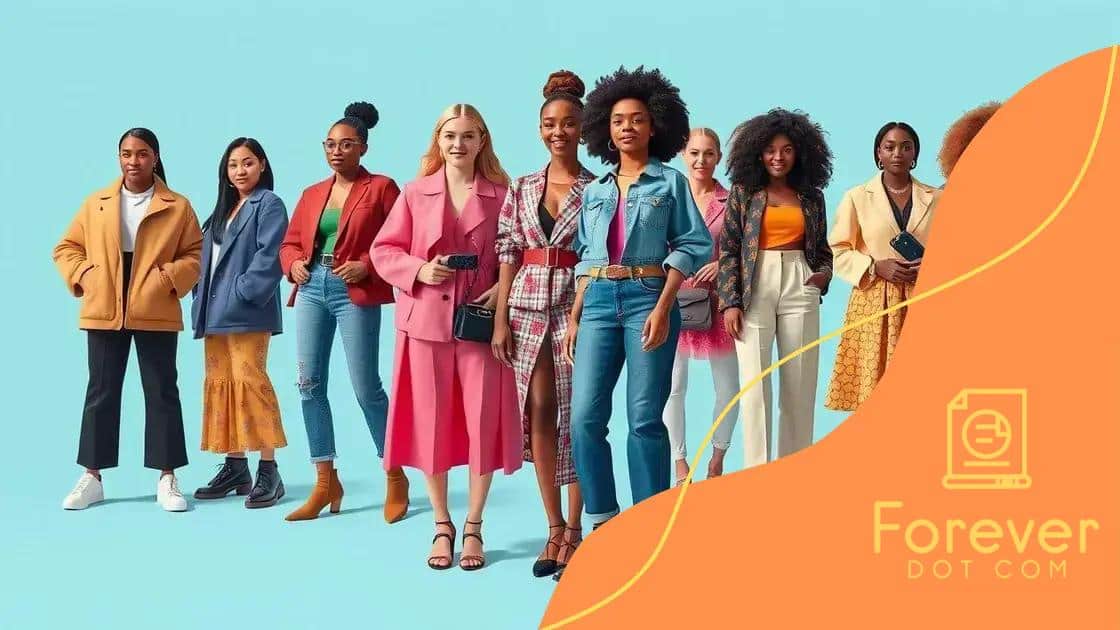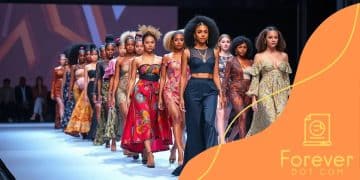The evolution of plus-size models in high fashion

The evolution of plus-size models in high fashion showcases the growing acceptance and representation of diverse body types, driven by social media, technological advancements, and major brands adopting inclusive practices.
When we think about fashion, do we also consider how it evolves? The evolution of plus-size models in high fashion reflects changing standards of beauty and inclusivity. How does this impact what we see on runways and in stores today?
A brief history of plus-size modeling
The history of plus-size modeling is rich and complex, reflecting changing societal attitudes toward body image and diversity. In the early days of fashion, models were predominately thin, and the ideal body type was narrow. However, as society evolved, so did the representation of different body types in the industry.
In the 1970s, the plus-size movement began to gain traction, as models like Emme paved the way for more inclusive standards. This era saw a gradual increase in the visibility of plus-size women in fashion magazines and advertisements, marking the beginning of a shift in industry norms.
Key Milestones in Plus-Size Modeling
Several milestones have significantly impacted the acceptance of plus-size models:
- 1980s: The introduction of plus-size lines by major retailers helped to legitimize the market.
- 1990s: Models like Kate Dillon and Heather Hazzan challenged the status quo, appearing in prominent editorials.
- 2000s: The term “plus-size” became more mainstream, with brands launching specialized collections.
This growing acceptance paved the way for today’s diverse representation in fashion. Major fashion shows now often feature models of various sizes, showcasing a wider range of beauty.
Additionally, the rise of social media has enhanced visibility for plus-size models, allowing them to build personal brands and connect directly with their audience. Platforms like Instagram have empowered many to challenge traditional beauty standards. This has led to an increase in collaborations with brands that prioritize inclusivity.
The Future of Plus-Size Modeling
As we look ahead, the future of plus-size modeling seems bright. With ongoing discussions surrounding body positivity and diversity, the fashion industry is likely to continue adapting. Embracing all body types can lead to a richer, more inclusive fashion landscape that better reflects our society.
Cultural shifts influencing body positivity
Cultural shifts have played a vital role in shaping the conversation around body positivity. Over the years, diverse movements have emerged, advocating for acceptance and self-love in a world dominated by narrow beauty standards.
One key moment in this evolution was the body positivity movement of the 1990s. This movement aimed to challenge societal norms that dictated what a “perfect” body should look like. It encouraged individuals to appreciate their bodies, regardless of size or shape, promoting the idea that every body is beautiful.
Major Influences on Body Positivity
Several factors have contributed to the rise of body positivity:
- Media Representation: Increased visibility of diverse body types in media has helped challenge outdated stereotypes.
- Social Media: Platforms like Instagram have allowed individuals to share their own narratives, celebrating various body shapes.
- Activism: Advocates have worked tirelessly to bring attention to the harmful effects of unrealistic beauty standards.
As a result of these influences, more people are beginning to celebrate their individuality. Celebrities and influencers now promote body positivity, often sharing their journeys toward self-acceptance. This visibility plays a crucial role in inspiring others to embrace their own bodies.
Moreover, discussions surrounding mental health and the impact of body image on self-esteem have sparked a necessary dialogue. People are now more aware of how societal pressures can affect their mental well-being, leading to greater acceptance and understanding of body diversity.
The Future of Body Positivity
Looking ahead, it will be interesting to see how these cultural shifts continue to evolve. As more brands and designers embrace inclusivity, the fashion industry may transform to better reflect society’s diverse bodies. The growing support for body positivity shows no signs of slowing down, promising a future where acceptance becomes the norm.
Impact of social media on fashion representation

The impact of social media on fashion representation has been transformative and profound. In recent years, platforms like Instagram and TikTok have revolutionized how fashion is showcased. Individuals from all over the world can now share their styles, breaking away from traditional modeling norms.
Many fashion influencers have gained popularity for embracing their authenticity. This shift challenges the conventional beauty standards that dominated the industry for so long. Today, we see a wide range of body types, skin tones, and styles represented online. This has encouraged countless individuals to express themselves creatively.
Key Changes Brought by Social Media
Several significant changes have occurred due to the influence of social media:
- Diversity: Social media has amplified voices of underrepresented groups, allowing for more diversity in fashion.
- Accessibility: Everyday people can now showcase their fashion sense, making style inspiration accessible to all.
- Real-Time Engagement: Brands can interact with consumers directly, gathering feedback and adjusting strategies accordingly.
This direct engagement has led to a more dynamic fashion industry. Brands are increasingly prioritizing inclusivity, realizing that their customers want to see themselves represented. Through collaborations with influencers of all sizes and styles, they are shifting towards meaningful fashion representation.
Moreover, social media campaigns have encouraged a more significant conversation about body image and self-love. Influencers often share their journeys, which helps their followers relate and feel empowered. The message is clear: fashion is for everyone.
The Future of Fashion Representation
As social media continues to evolve, it will undoubtedly shape the future of fashion representation. With the ongoing demand for authenticity and inclusivity, fashion brands will have to keep pace. The landscape is changing rapidly, and those who adapt will find success in a more diverse and accepting industry.
Major brands embracing plus-size diversity
Major brands embracing plus-size diversity are reshaping the fashion landscape. These companies are beginning to understand that beauty comes in all shapes and sizes. By including plus-size options, they are making a statement about inclusivity.
In the past, many fashion brands ignored the plus-size market. However, a significant shift has occurred as consumers demand more representation. Brands like Ashley Graham’s collaboration with PrettyLittleThing and Savage X Fenty by Rihanna have set the standard for embracing curves. This not only provides more options but also celebrates body positivity.
Key Influencers of Change
Several major brands have taken notable steps toward inclusivity:
- Target: This retailer has expanded its plus-size offerings, making stylish clothes accessible to everyone.
- Addison Rae for American Eagle: The partnership launched a diverse collection, showcasing different body types.
- ASOS: This brand prides itself on offering sizes from 0 to 26, promoting inclusivity at every level.
These brands recognize that a diverse customer base deserves to see itself reflected in their products. As they expand their size ranges, they create a broader market that benefits everyone. Moreover, many brands are using real customers in their advertising campaigns. This practice helps customers relate to the models and see themselves in the clothes.
Additionally, the rise of social media has made it easier for brands to connect with their audience about representation. Consumers are vocal about what they want, and brands that listen are finding great success. This feedback loop creates a positive environment for both brands and consumers alike.
The Impact of Plus-Size Lines
Embracing plus-size diversity can have a significant impact on brand loyalty and market growth. Customers appreciate brands that take a stand for inclusivity. By offering a variety of sizes and styles, brands can attract a wider audience and encourage more positive conversations surrounding body image.
Future trends in plus-size modeling
The future trends in plus-size modeling are set to be exciting and transformative. As the fashion industry becomes increasingly aware of diverse body types, we can expect significant changes that promote inclusivity and representation.
One major trend is the continuous push for inclusivity in advertising and campaigns. Brands are realizing that showcasing models of various sizes and shapes not only resonates with customers but also boosts sales. Consumers today want to see themselves reflected in the brands they support.
Innovations in Fashion Technology
With advancements in technology, innovations are shaping the future of plus-size modeling:
- Virtual Fitting Rooms: These will allow customers to see how clothing might fit their unique body shape, making online shopping more accessible.
- 3D Body Scanning: This technology can help brands create garments tailored to various body types, enhancing fit and comfort.
- Sustainable Fashion: As awareness of environmental issues grows, brands are now combining inclusivity with sustainability, offering eco-friendly plus-size collections.
These technological advancements will not only improve the shopping experience but also empower individuals to embrace their bodies. Furthermore, social media’s influence will continue to play a crucial role in promoting body positivity. As more influencers and everyday individuals share their unique styles, they challenge the traditional definitions of beauty.
The Role of Emerging Models
New models are emerging who prioritize empowerment and self-love. They are not just representing clothing but also promoting messages of acceptance and confidence. This cultural shift encourages individuals to embrace their bodies, rejecting the notion of a “perfect size.” With platforms like TikTok and Instagram, models can share their experiences and connect with larger audiences.
The future of plus-size modeling holds the promise of a more diverse and inclusive fashion industry. Brands that adapt to these changes are likely to thrive, as consumers seek authentic representation that resonates with their values. With growing awareness and support, the modeling landscape will continue to evolve.
The future of plus-size modeling is bright and full of promise. As brands embrace diversity and inclusivity, we can expect to see more representation in the fashion industry. Innovative technologies are set to enhance the shopping experience, while emerging models advocate for self-love and body positivity. With the support of social media, these changes will help challenge traditional beauty standards, ensuring that every individual feels seen and valued. By continuing to embrace and celebrate all body types, the fashion world is paving the way for a more inclusive and understanding future.
FAQ – Frequently Asked Questions About Plus-Size Modeling
What impact does social media have on plus-size modeling?
Social media platforms allow diverse voices to be heard, promoting body positivity and helping brands understand consumer demands for inclusivity.
How are major brands embracing plus-size diversity?
Brands are expanding their size offerings and showcasing plus-size models in campaigns, reflecting the diverse beauty of their customer base.
What technological advancements are helping plus-size fashion?
Innovations like virtual fitting rooms and 3D body scanning are making fashion more accessible and tailored for all body types.
Why is body positivity important in fashion?
Body positivity promotes self-acceptance and confidence, challenging traditional beauty standards and ensuring everyone feels represented in fashion.






